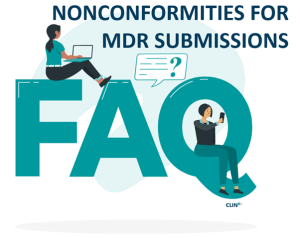Nonconformities for MDR submissions FAQS

Q: What does a Notified Body want from your Technical Documentation?
A: Notified bodies expect technical documentation to be clear, organized, searchable, and unambiguous, meeting the requirements specified in the legislation. Manufacturers must thoroughly review their technical documentation packages for device-specific elements before submission, as reviewers scrutinize every detail.
Manufacturers often find that the expectations outlined by MDCG and any interim notified body reviews were accurate when MDR audit feedback is received. Compliance with detailed evidence is essential, and notified bodies anticipate quicker correction turnaround times compared to previous years. Manufacturers should not attempt to submit documentation with technical gaps, as notified bodies are unlikely to accommodate such submissions.
Q: What will the Notified Body give deficiencies for?
A: Deficiency reports highlight areas of nonconformity in technical documentation. These deficiencies typically fall into several categories, including device description and specification, testing, risk management, post-market surveillance, and general safety and performance requirements.
Q: What are common nonconformities identified in the assessment of Technical Documentation under the EU MDR?
A:
- Device Description and Specification Nonconformities.
- Testing Nonconformities.
- Risk Nonconformities.
- Post Market Surveillance Nonconformities.
- General Safety and Performance Requirement (GSPR) Nonconformities.
Q: What are common Device Description and Specification Nonconformities?
A: Nonconformities in this category may include unclear definitions of intended use, inadequate explanation of device history or principle of operation, lack of comprehensive component compatibility lists, absence of a bill of materials (BOM), and failure to reference applicable standards accurately.
Q: What are common Testing Nonconformities?
A: Testing-related nonconformities may involve issues such as insufficient explanation of sample selection for testing, lack of clarity on material specifications, omission of relevant standards in validation testing, and inadequate validation of product lifetime.
Q: What are common Risk Nonconformities?
A: Nonconformities related to risk management may include missing risk management plans for each device, incomplete risk management files, failure to identify risks synonymous with device category, and inadequate integration of inputs from clinical evaluation and post-market surveillance into risk management assessments.
Q: What are common Post Market Surveillance (PMS) Nonconformities?
A: Nonconformities in post-market surveillance may include the absence of a PMS plan for each device, lack of proactive PMS activities or PMCF plans, and failure to track residual risks or risks impacting benefit-risk profile adequately.
Q: What are common General Safety and Performance Requirement (GSPR) Nonconformities?
A: GSPR nonconformities may involve insufficient clarity on how specific GSPR sections are addressed in technical documents, lack of justification for applicability or non-applicability of specific GSPR sections, and inadequate explanation of how labelling and instructions for use meet GSPR requirements.
Q: What can mitigate risks and ensure compliance with the EU MDR requirements during the Technical Documentation assessment process?
A: Strict adherence to EU MDR requirements is crucial for successful assessment. Manufacturers should prioritize compliance and ensure their technical documentation meets all specified standards.
You can also consider partnering with a clinical regulatory affairs consultancy that can provide valuable support in navigating MDR compliance. Experienced consultants can identify and address any skills or resource gaps, significantly reducing the burden of maintaining compliant technical documentation.



